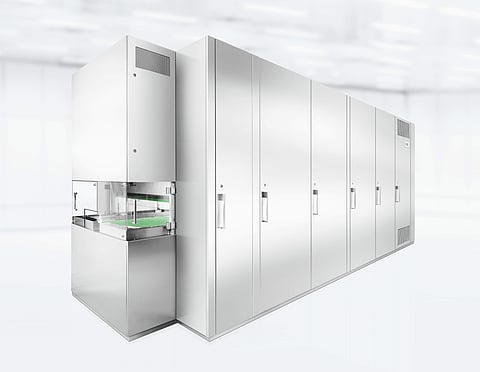
- Home
- EventsEvents
- Product Launches
- CategoriesCategories
- Advertise
- Opinion

Sustainability and climate protection not only dominate public discourse; they also influence everyday production in the pharmaceutical and food industries. To help them reduce their environmental footprints, Syntegon has developed a method, which calculates the carbon emissions of its machines along their entire life cycle. However, the analysis is only one side of the sustainability coin.
The sustainable use of energy and other resources has been posing a major challenge to the pharmaceutical and food industries – way before the current rise in energy prices. Manufacturing companies are aiming to minimize their environmental impact and resource consumption as far as possible. In doing so, they are also placing a stronger focus on their equipment. For example, energy-intensive pharmaceutical machines such as sterilization tunnels require companies to rethink their production processes. In addition to safety procedures, these companies are looking for ways to significantly reduce their equipment’s energy consumption. They need to find a way to augment energy efficiency without impacting consistent quality and validated parameters. Precise data is the key to potential energy savings.
Fully transparent carbon footprints
Syntegon has developed a method to determine and evaluate emissions from machines over their entire life cycle – in keeping with so-called Life Cycle Assessments (LCA). Certified by TÜV Rheinland (a German Association for Technical Inspection) in 2022, the software-based calculation model lays the basis for effective consulting, energy-efficient operations, and technical optimization of the company's equipment.
“Our analysis can calculate a broad range of emissions, from the machines’ construction and use phase to shutdown and disposal,” says Steffen Carbon, head - environmentally compatible product design, Syntegon. The use phase accounts for more than two-thirds of the entire life cycle, consuming the most energy and causing a considerable share of overall emissions. During footprint calculation, Syntegon’s method includes parameters such as electricity, compressed air, media, and packaging materials. “This data allows us to improve the machines and processes of companies eager to achieve sustainable production processes and reduce costs.”
Data connectivity is key
More specifically, the calculation correlates so-called 'activity data', which is recorded during production and operation, with specific carbon footprints provided by Ecoinvent. The Swiss non-profit organization hosts a database comprising general emission information that may be relevant for the analysis. Parameters include construction materials like stainless steel or certain operating materials, including cleaning media. The database helps Syntegon to draw representative and evidence-based conclusions about the emissions of specific machines.
Syntegon tested the first model of its consumption analysis in 2021 with its own Elematic 3001 case packer and its GKF 720 capsule-filling machine. At that time, the analysis covered phases from production to transport and operation. Last year, Syntegon extended the scope of its Life Cycle Assessment method to include the complete end-of-line (EOL) phase. “We are now also able to calculate the carbon footprint at shutdown, disposal, and recycling,” Carbon explains. The analysis considers key steps such as disassembly, removal, recycling of materials, and disposal of waste in a landfill.
Example: LCA of a sterilization tunnel
The energy-intensive sterilization tunnel mentioned above helps to illustrate how much greenhouse gases the equipment emits in each phase. 90 percent of all carbon emissions occur during usage. Materials rank second highest, while the equipment’s end-of-life amounts to less than one percent of the emissions during the entire life cycle.
Syntegon relies on simulation tools to analyze the use phase. “We take a wealth of parameters into account, for example, the average service life of the equipment, but also the times for commissioning, heating up tools, and performing maintenance activities, as well as downtimes,” explains Torsten Sauer, director - Sustainability, Syntegon. “We can even calculate the impact of packaging materials on emissions, leading to the most comprehensive analysis possible.”
From modeling to concrete measures
The theoretical calculation of emission, however, is not enough for Syntegon’s ambitious goal. “We create added value not only by showing companies where to save energy but also by giving them specific recommendations on how to do it,” says Sauer. Again, the sterilization tunnel is a good example of how Syntegon tackles this task. Depending on the operating state, the machine uses different amounts of energy, thus offering several levers for more ecological operations that compromise neither quality nor validation.
The sterilization tunnel with a length of several meters consumes up to 15 percent more energy during heating than during operation. Cleverly used operating states offer the potential for savings – but also require a change of mindset. “Evidence shows that many manufacturing companies keep their tunnels ready for operation, i. e. in high-level standby mode, for very long periods to reduce heating energy, even if they only use them for a few hours a day. They only switch to low-level standby with less power consumption on weekends,” Carbon explains.
This operating mode ensures sterile conditions at a temperature of 130 degrees Celsius. However, the tunnel must be heated up to 350 degrees Celsius again for regular production. Using its LCA analysis Syntegon was able to prove that there is another viable approach, “Our analysis showed that low-level standby is also possible during weekday downtimes without jeopardizing sterilization quality. Compared to high-level standby, manufacturing companies can save up to ten percent of electricity – without having to requalify the system,” Carbon points out.
Expanding carbon consulting
Besides operating conditions, Syntegon also analyzes further variables and their effects on the carbon footprint. The sustainability experts have created blueprints for carbon consulting that focus on consumption and carbon values so that clients can use the calculation models in the long term. “We can precisely determine the emissions for specific use cases. Test runs with food and pharmaceutical manufacturing companies are therefore a top priority,” Sauer adds. Syntegon further intends to use the test data for its purposes, for example, to optimize the machines in its portfolio or to develop new solutions for respective industries.
Click HERE to subscribe to our FREE Weekly Newsletter
